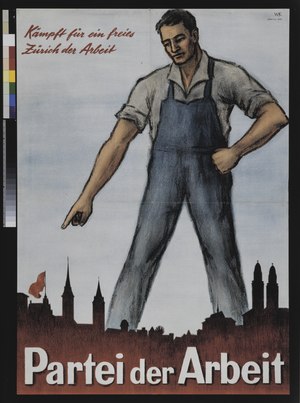
Unternavigation
The Swiss Workers Party (Partei der Arbeit - PdA)
The Swiss Workers Party (PdA), founded in 1944, has remained a minor party with a very modest voter base. As a result, it had few opportunities to affect the design of social welfare measures. However, in particular cases, targeted actions the PdA undertook did allow it to exert some influence on the development of social policy.
The Communist Party of Switzerland (KPS, founded in 1921) emerged as a fusion of various left-wing and socialist movements. Decisive reference points for the KPS were provided by political internationalism and the global revolution. But the percentage of voters who were attracted to it remained low; at the national level, in the 1920s, it was 2% at best. Various cantons banned the KPS, and in 1940 the Swiss Federal Council prohibited it from indulging in any activity whatsoever, nationwide. However, fresh impetus was given to the communist and anti-fascist movements in Switzerland during the first half of the 1940s, as the Soviet Union had joining the Allies to fight Nazi Germany. Though the Communist International dissolved in 1943, the Swiss Workers Party was founded in October of 1944, supported by former members of the KPS, left-wing Social Democrats, and various other political sympathizers.
The PdA grew quickly and achieved notable electoral successes in the second half of the 1940s. In 1947, it received 5.1% of the votes at the national level – the highest percentage the PdA ever achieved in its history. But due to the Cold War, and as a result of a wave of anti-communist sentiment, the PdA lost significance and found itself increasingly in the political wilderness. The 1980s saw a further decline, partly the result of members leaving the party and partly owing to poor election results. The fall of the Berlin Wall in 1989 and the break-up of the Soviet Union in 1991 called for a new orientation of the party. The PdA subsequently did distance itself more clearly from Soviet dogmas, but continued to declare its political goals to be the smashing of capitalism and working towards a transition to a socialist society. In the 1940s, the PdA was able to maintain regional parties in 18 cantons; today, that number has fallen to just 8 cantons.
In the realm of social welfare, the PdA advocated centralized, welfare state solutions and was skeptical about private sector or ‘social partnership’ (‘Sozialpartnerschaft’) approaches. It nevertheless had some social policy successes, and helped shape and expand the social welfare state in the postwar era.
Since its founding, the PdA had called for an Old Age and Survivors’ Insurance (AHV) scheme. An initial proposal made in 1931 by the federal authorities was rejected by the KPS as wholly insufficient. Later, the PdA would come to argue for an increase in AHV pension levels. AVIVO, an interest group that brought together seniors, the disabled, widows, and orphans and which was closely aligned with the PdA, was very active in this effort. In addition, the PdA favored introducing a disability insurance scheme. However, more middle-class circles, the Federal Council, and experts in the relevant public administration bureaus showed no great enthusiasm – at least not until the 1950s – to do the necessary work to introduce disability insurance. Because of this inaction, the PdA launched a popular initiative in 1954 ‘to create a national disability insurance’ scheme, arguing that those afflicted needed to have a pension sufficient to live on. Soon thereafter, the Social Democratic Party (SP) also began collecting signatures for a popular initiative ‘to introduce disability insurance’. Under pressure from these initiatives, both of which called for extensive pension coverage, the Federal Council and the public authorities themselves became active and subsequently worked out a draft law for disability insurance they found acceptable. This social welfare benefit was finally approved in Parliament and implemented in 1960. During the 1950s, the PdA also demanded maternity insurance and unemployment insurance be introduced.
The PdA’s efforts in the area of social security continued with an initiative launched in 1969 calling ‘for the introduction of a popular pension’. This was directed against existing practices in providing old-age benefits, and called for integrating private sector pension funds into an institutional framework managed by the public authorities. At about the same time, the SP launched its own AHV initiative, one which would have provided somewhat greater scope for action by the pension funds. While the PdA argued for a ‘single-pillar’ system, the SP advocated a ‘two-pillar’ system. Middle-class and more conservative circles were worried by the PdA’s initiative, since from their point of view, a ‘three-pillar’ system was the more desirable format, and would include a compulsory occupation-linked pension system (called the ‘second pillar’). To keep the AHV from becoming comprehensive and functioning as a ‘people’s pension’, and to strengthen the ‘three-pillar system’, the middle-class and conservative parties suggested making the occupation-linked part of the pension system obligatory, and on their part, also launched a popular initiative called ‘for an up-to-date Old-Age, Survivors, and Disability Insurance scheme’. In the run-up to the 1972 vote held on the PdA’s initiative, all the other parties came out in favor of the counter-proposal of the middle-class parties. This counter-proposal was accepted by the voters. In the mid-1970s, the PdA also planned on launching a popular initiative calling for reducing the retirement age to 60, through this plan never came to fruition. While the PdA thus could pride itself on its respectable contributions to expanding social welfare benefits during the ‘golden years’ of the postwar era, it has played only a minor role in social welfare policy formation since the 1980s.
Literatur / Bibliographie / Bibliografia / References: Canonica, Alan (2017), Der gute Wille zählt. Konventionen der beruflichen Eingliederung Behinderter zwischen Invalidenversicherung und Arbeitgeber (1945-2008), Dissertation Universität Basel, 2017; Fracheboud, Virginie (2015), L’introduction de l’assurance invalidité en Suisse (1944-1960). Tensions au cœur de l’état social, Lausanne; Rauber, André (2003), Formierter Widerstand. Geschichte der kommunistischen Bewegung in der Schweiz 1944-1991, Zürich.
(12/2017)




